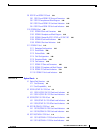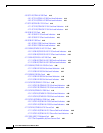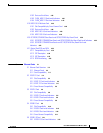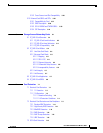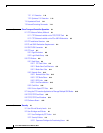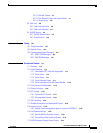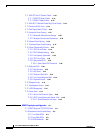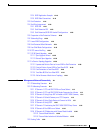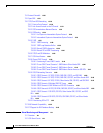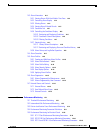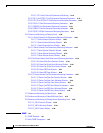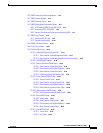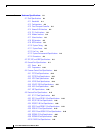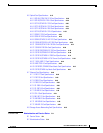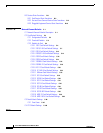
Contents
xv
Cisco ONS 15454 Reference Manual, R8.5.x
78-18106-01
12.2.4 BLSR Application Example 12-10
12.2.5 BLSR Fiber Connections 12-13
12.3 Path Protection 12-14
12.4 Dual-Ring Interconnect 12-19
12.4.1 BLSR DRI 12-19
12.4.2 Path Protection DRI 12-23
12.4.3 Path Protection/BLSR DRI Handoff Configurations 12-26
12.5 Comparison of the Protection Schemes 12-28
12.6 Subtending Rings 12-29
12.7 Linear ADM Configurations 12-31
12.8 Path-Protected Mesh Networks 12-31
12.9 Four-Shelf Node Configurations 12-33
12.10 STS around the Ring 12-34
12.11 OC-N Speed Upgrades 12-35
12.11.1 Span Upgrade Wizard 12-38
12.11.2 Manual Span Upgrades 12-38
12.12 In-Service Topology Upgrades 12-38
12.12.1 Unprotected Point-to-Point or Linear ADM to Path Protection 12-39
12.12.2 Point-to-Point or Linear ADM to Two-Fiber BLSR 12-40
12.12.3 Path Protection to Two-Fiber BLSR 12-40
12.12.4 Two-Fiber BLSR to Four-Fiber BLSR 12-41
12.12.5 Add or Remove a Node from a Topology 12-41
CHAPTER
13 Management Network Connectivity 13-1
13.1 IP Networking Overview 13-1
13.2 IP Addressing Scenarios 13-2
13.2.1 IP Scenario 1: CTC and ONS 15454s on Same Subnet 13-3
13.2.2 IP Scenario 2: CTC and ONS 15454 Nodes Connected to a Router 13-3
13.2.3 IP Scenario 3: Using Proxy ARP to Enable an ONS 15454 Gateway 13-4
13.2.4 IP Scenario 4: Default Gateway on a CTC Computer 13-6
13.2.5 IP Scenario 5: Using Static Routes to Connect to LANs 13-7
13.2.6 IP Scenario 6: Using OSPF 13-10
13.2.7 IP Scenario 7: Provisioning the ONS 15454 SOCKS Proxy Server 13-12
13.2.8 IP Scenario 8: Dual GNEs on a Subnet 13-18
13.2.9 IP Scenario 9: IP Addressing with Secure Mode Enabled 13-20
13.2.9.1 Secure Mode Behavior 13-20
13.2.9.2 Secure Node Locked and Unlocked Behavior 13-23
13.3 Routing Table 13-24



